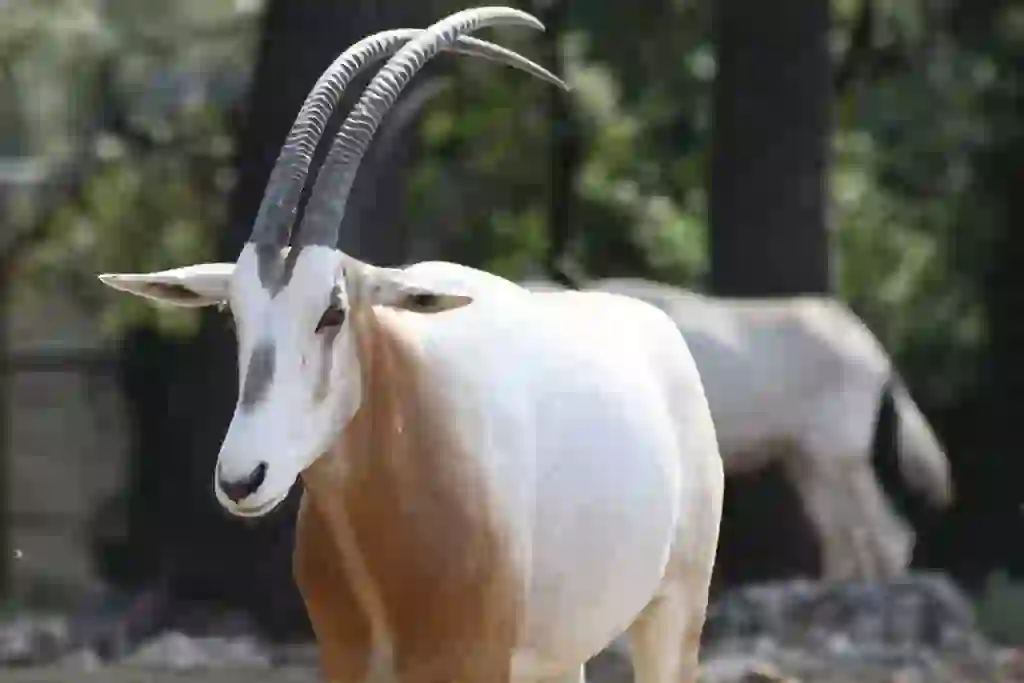
Scimitar-horned Oryx
Scimitar-horned Oryx
Scimitar-horned Oryx
Do you know the scimitar-horned oryx, a herbivore that once lived in Africa? Scimitar-horned oryx is an animal characterized by a beautiful long horn that is slightly curved and stretched backwards. They can be seen in some zoos, but they are also animals with a sad history of not being seen in the wild. In this article, let's take a peek at the characteristics and secrets of scimitar-horned oryx and its life together!
Scimitar-horned Oryx Basic Infomation
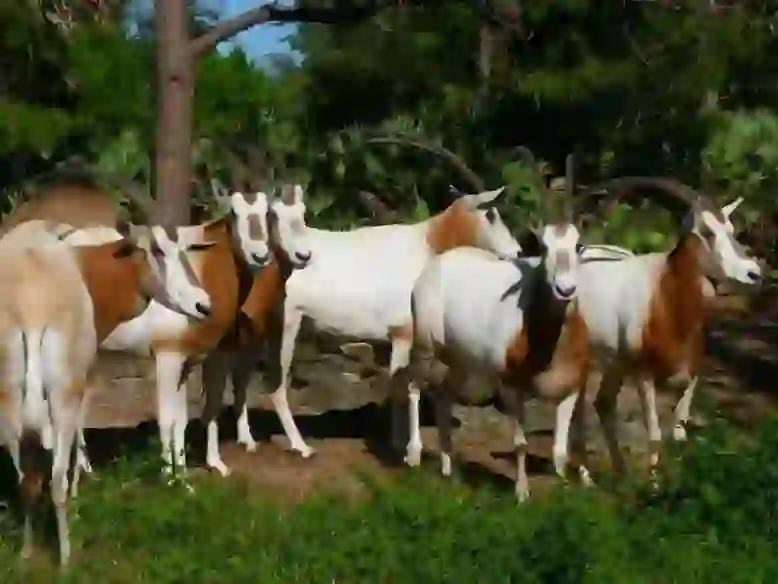
Mammalia-Artiodactyla-Bovidae-oryx genus.
Length:160~175cm. Weight:130~210Kg.
Scimitar-horned oryx is a herbivorous animal belonging to the genus Oryx in the Bovidae family that once lived widely in North Africa. Because it lived in semi-desert areas, it seems that it often acted mainly in the evening, night, and early morning to avoid high daytime temperatures.
The body color of the scimitar-horned oryx is mostly white, with light brown patterns around the eyes, neck, back, etc. Both males and females have long horns that curve slightly backward, which is their biggest feature. However, it seems that the thickness of the horns of females is slightly thinner than that of males.
Scimitar-horned oryx reach sexual maturity at around 1.5 to 2 years old and become able to breed. The gestation period is about 8 months, and females usually give birth to one baby at a time.
Scimitar-horned Oryx Q&A

What is the origin of the name scimitar-horned oryx?
In English, it is called "scimitar-horned oryx", but in fact, in the case of Japanese, it is named "shirooryx".
Why is it called shirooryx in Japanese this time? Why is it called scimitar-horned oryx in English? We will introduce the origin of each.
First of all, the reason why it is called shirooryx in the Japanese, but unfortunately I could not find a clear origin of the name shirooryx. However, it is probably a member of the oryx family, and it came to be called "shirooryx" because most of its body color is white. It is considered to be.
※White is called "shiro" in Japanese.
Next, the origin of the word scimitar-horned oryx in English is the "scimitar", a weapon with a curved blade used in the Middle East, and it seems that this name was given because this weapon and the horn of the scimitar-horned oryx were similar.By the way, the scientific name is expressed as "oryx dammah".
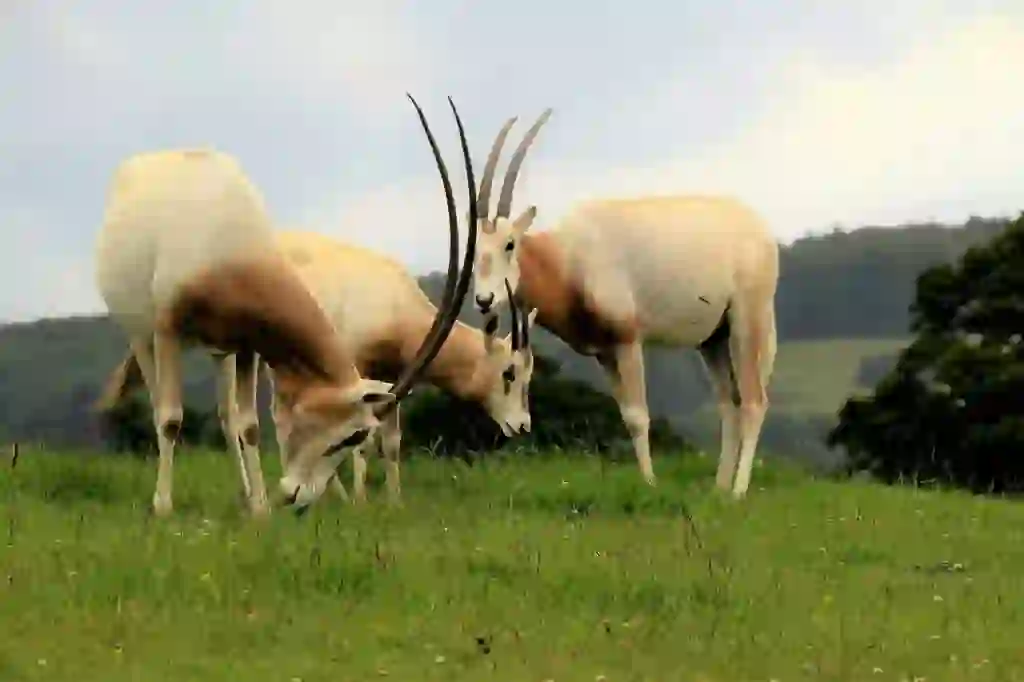
Why do scimitar-horned oryx live there?
Scimitar-horned oryx originally lived in semi-desert areas (Morocco, Tunisia, Algeria, Libya, Egypt, Mauritania, Mali, Niger, Chad, and some parts of Sudan) around the Sahara Desert in Africa where plants grew sparsely.
It is unclear why scimitar-horned oryx chose the desert as their habitat where it is hot during the day and cold at night with sparse vegetation. However, considering that scimitar-horned oryx thrived in this area, it is believed that this place was worth living for scimitar-horned oryx even if it meant changing their body structure.

What does scimitar-horned oryx eat?
Scimitar-horned oryx is a herbivorous animal that eats everything from grass and plant leaves and roots to seeds and buds in the wild. They used to form herds and move across vast lands seeking grass that became food depending on the season.
In zoos, they are fed with bluegrass, hay, and pellets for herbivores
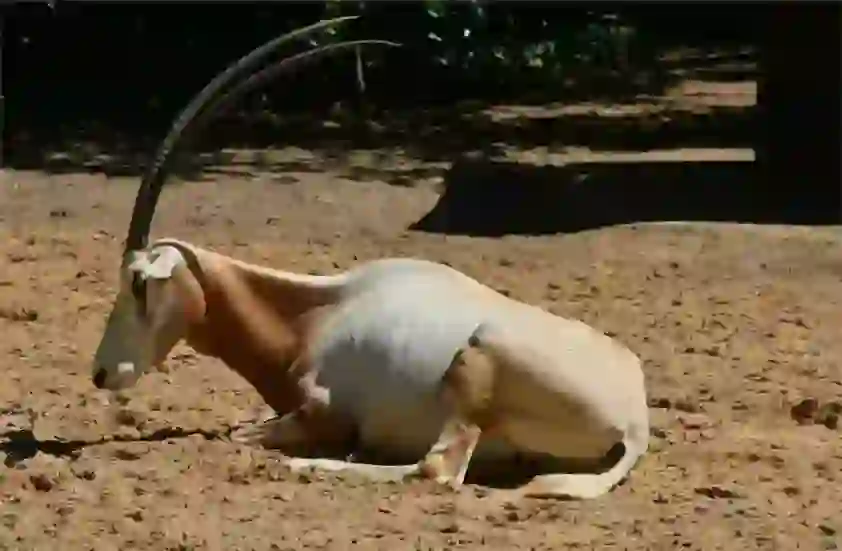
What is the role of the horn of scimitar-horned oryx?
Scimitar-horned oryx’s horns grow in both males and females and their large feature is that they curve gently backwards. What is the role of the scimitar-horned oryx’s horns that can sometimes exceed 1m in length?
In fact, scimitar-horned oryx mainly use these long horns as weapons. During the breeding season, male scimitar-horned oryx lower their heads and compete with each other by butting their horns together. Only the male who wins the fight can acquire females and obtain the right to breed.
In zoos, scimitar-horned oryx have been observed using their horns like grandchildren’s hands to scratch their bodies.
By the way, the inside of scimitar-horned oryx’s horns is hollow and once broken, they will never grow again.

Scimitar-horned oryx really does make a harem?
It's true.
Scimitar-horned oryx, which once lived in the wild, is said to have created a harem led by one male with 20-40 females. During the season when there was plenty of water for migration, groups of scimitar-horned oryx exceeding 1,000 were seen.

How can scimitar-horned oryx survive in the desert?
As I explained earlier, scimitar-horned oryx once lived in semi-desert areas in northern Africa.
Deserts are harsh environments where it can get very hot during the day and below freezing at night. It is also very difficult to obtain the water that all living things need to survive, so living in the desert is very difficult.
So how did scimitar-horned oryx survive and thrive in the desert?
In fact, scimitar-horned oryx has a special body structure that is suitable for dryness and high temperatures.
First of all, scimitar-horned oryx can obtain the necessary water to survive by using the small amount of water contained in food and by licking dew on rocks. Therefore, scimitar-horned oryx living in the desert can survive for long periods of time without drinking water.
Animals are divided into poikilothermic animals whose body temperature changes with the temperature and homeothermic animals whose body temperature remains constant.
Most mammals are homeothermic animals and their bodies naturally maintain a constant body temperature even when it is hot or cold, but scimitar-horned oryx has a special ability to change its body temperature to some extent depending on the temperature despite being a homeothermic animal.
When it is hot, the scimitar-horned oryx raises its body temperature to about 45℃ so that it does not sweat, and then cools down its high body temperature with the coldness of the night to return to its normal body temperature.
It can also use its ability to cool the capillaries in its nasal cavity by inhaling and exhaling through its nose to cool the blood flowing to its brain, and to concentrate its feces and urine to minimize the amount of water lost from its body.
In addition, its ears are covered with dense hair to prevent sand from entering, and its body color is white to reflect strong sunlight. Its hooves are also enlarged for easy walking on sand.
The scimitar-horned oryx has many mechanisms that allow it to survive in hot and dry deserts.

Can scimitar-horned oryx be kept as a pet?
When breeding rare animals at home, it is necessary to follow the established laws in some countries. This time, we will introduce whether it is possible to breed scimitar-horned oryx at home in Japan.
The scimitar-horned oryx is an animal listed in Appendix I as a species that is endangered by trade or may be affected by trade under the Washington Convention, which is an international agreement to protect wild flora and fauna.
Animals classified in Appendix I are particularly at risk of extinction and are protected worldwide, so it is stipulated that they cannot be traded between countries unless there are special purposes such as research.
Although breeding of scimitar-horned oryxes is not prohibited, it is almost impossible to obtain them as pets due to the above reasons.

Is there a place to see scimitar-horned oryx in Japan?
Scimitar-horned oryx are kept in many zoos such as Tama Zoological Park in Tokyo, Tobe Zoo in Ehime Prefecture, and Adventure World in Wakayama Prefecture.
By the way, at safari parks such as "Kyushu Natural Zoological Park African Safari" in Oita Prefecture and "Himeji Central Park" in Hyogo Prefecture, you can observe scimitar-horned oryx spending time with other herbivores such as antelopes.

What is the lifespan of scimitar-horned oryx?
The lifespan of wild Scimitar-horned oryx is not clear, but it is believed to be around 11-15 years (15-20 years) . In captivity, they can live for more than 20 years.
There are records of “Lazania” who was kept at Chiba City Zoological Park living up to 21 years old and “Pepe” who was kept at Tama Zoological Park living up to 18 years old in Japan.
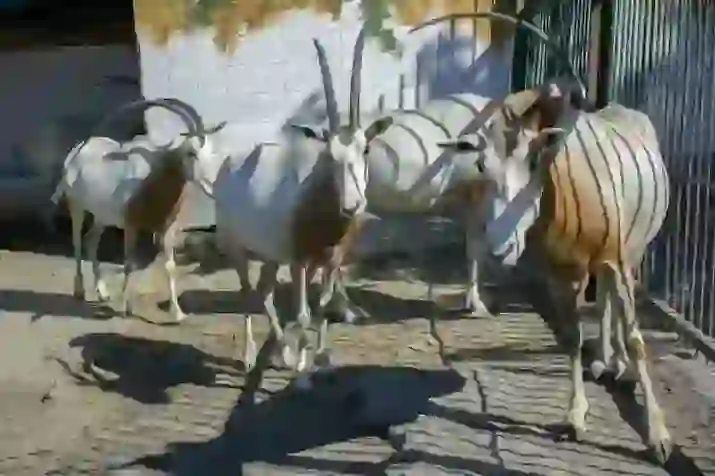
What enemies does scimitar-horned oryx have?
The natural enemies of the Scimitar-horned oryx in the wild are carnivorous animals such as lions, hyenas, wild dogs and vultures.
However, it is said that healthy adult Scimitar-horned oryx, especially males, are almost never attacked by these animals due to their aggressive temperament. However, it seems that young individuals or those weakened by illness or injury are sometimes attacked.
For such a scimitar-horned oryx, the greatest natural enemy is undoubtedly us humans.
Scimitar-horned oryxes inhabit a wide range of northern Africa and it is believed that their population once exceeded hundreds of thousands.
However, their numbers have been greatly reduced due to overhunting for their magnificent horns and meat, loss of valuable food to grazing livestock, and reduction in habitat and food due to development such as oil drilling.
And since 1988, the wild scimitar-horned oryx has never been confirmed.
Fortunately, however, it is classified as “extinct in the wild (EW)” because there were individuals that were bred in captivity and were able to breed under captivity even though they became extinct in the wild.
Currently, breeding and reproduction are being carried out in zoos around the world, and many international organizations and institutions such as the Environment Agency of Abu Dhabi, Sahara Conservation Fund, Chadian Government, Zoological Society of London, and Smithsonian Conservation Biology Institute are cooperating to try to return bred individuals to the wild.

Would you like to become a part of the 'Animalbook.jp'?
Turn your knowledge into Q&A and share it with the world. ※Publication will be activated after purchase. Let's share information together!
Scimitar-horned Oryx Type of List

- Scimitar-horned Oryx
Information
Congratulations! You are the first commenter!

Create Your Favorite List!
Scimitar-horned Oryx
Save the animals you love! Build your own list to quickly revisit your favorites later.

Would you like to leave a comment?
※Please note: This is for the purchase of rights to post comments within the article.
Find Your Favorites!
Our shop offers a unique and attractive selection of goods themed around various animals.
Scimitar-horned Oryx References

- 愛媛県立とべ動物園「シロオリックスのハチ(♀)が死亡しました。」 https://www.tobezoo.com/tobenews/animalinfo/2018/03283246.html
- Movement of Life「SCIMITAR-HORNED ORYX」 https://movementoflife.si.edu/species/scimitar-horned-oryx/
- 神戸市立王子動物園「はばたき第38号」 http://www.kobe-ojizoo.jp/habataki/pdf/habataki38.pdf
- 東京ズーネット「どうぶつ図鑑 シロオリックス」 https://www.tokyo-zoo.net/encyclopedia/species_detail?code=49
- 東京ズーネット「シロオリックスの「ペペ」が死亡しました」 https://www.tokyo-zoo.net/topic/topics_detail?kind=news&inst=tama&link_num=27145
- Smithsonian’s National Zoo & Conservation Biology Institute「SCIMITAR-HORNED ORYX 」 https://nationalzoo.si.edu/animals/scimitar-horned-oryx
- Greater Vancouver Zoo「SCIMITAR-HORNED ORYX 」 https://gvzoo.com/animals/animal/?permalink=scimitar-horned-oryx
- 「The biology, husbandry and conservation of scimitar-horned oryx (Oryx dammah)」 https://www.researchgate.net/publication/301295360_The_biology_husbandry_and_conservation_of_scimitar-horned_oryx_Oryx_dammah
- WWFジャパン「多様な地球の自然環境」 https://www.wwf.or.jp/activities/basicinfo/3401.html
- Twitter「千葉市動物公園【公式】」 https://x.com/ChibaZoo/status/1060709928568938496
Scimitar-horned Oryx Introduction of media used

出典:https://pixabay.com/images/id-1597449/

出典:https://commons.wikimedia.org/wiki/File:Oryx_Dammah_002.jpg

出典:https://pixabay.com/images/id-215882/

出典:https://commons.wikimedia.org/wiki/File:L'Oryx.jpg

出典:https://pixabay.com/images/id-5733293/
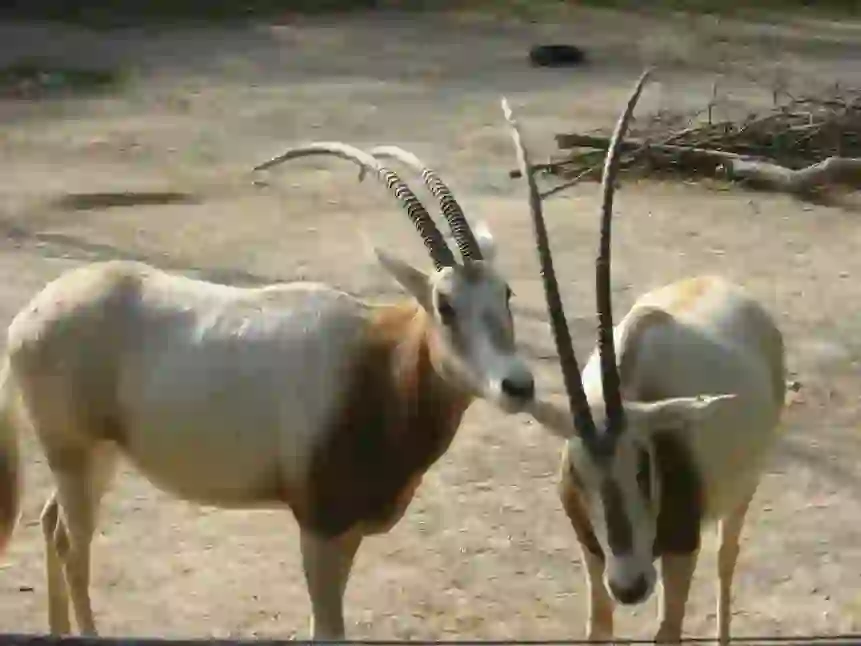
出典:https://commons.wikimedia.org/wiki/File:Scimitar-horned_oryx.jpg

enemy
出典:https://pixabay.com/images/id-6304198/
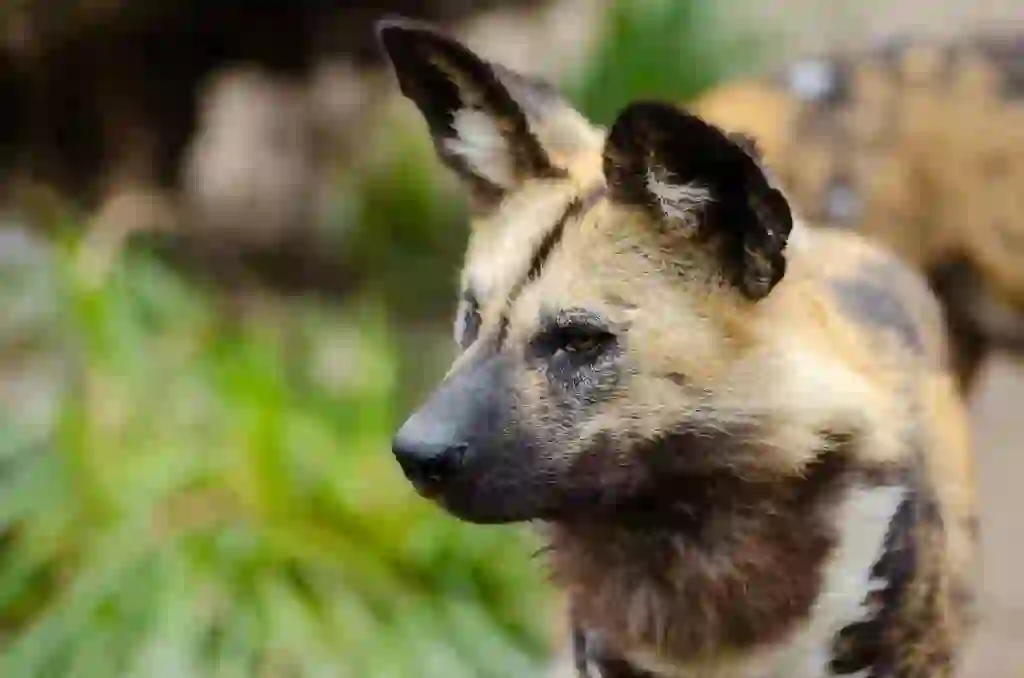
enemy
出典:https://pixabay.com/images/id-1332235/

Help Enrich Our Animalbook.jp with Your Media!
We are constantly looking to expand and enrich our Animalbook.jp with amazing photos and videos of animals. If you have any media that you'd like to share, please contribute and help us showcase the beauty and diversity of the animal kingdom. Your submissions will be credited and featured in our encyclopedia, reaching a wide audience of animal lovers.

















